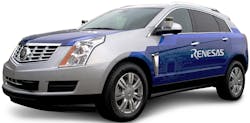This file type includes high resolution graphics and schematics when applicable.
The race to launch a commercially available self-driving car was front and center at this year’s Consumer Electronics Show. I took more than one ride in a self-driving vehicle and came out unscathed and usually awed by the current state of affairs. We are still a long way from a true self-driving car, but the gains that have been made in the last couple of years have been extremely impressive.
One area that is often left to the future is safety and reliability. Just getting things to work is a challenge. Most developers working in this area are addressing these issues, but they often do not talk about them much. The demo I had from Renesas did.
Renesas has worked with a number of partners—including Blackberry with its automotive software, the QNX RTOS. The latest demo is built around multiple Renesas’ R-Car starter kits that can meet the ASIL-B standard while each pair was managed by a Renesas RH850 that can meet ASIL-D. This should allow the combined system to meet ASIL-D requirements.
The particular demo utilized a triple, software-redundant configuration where three of four R-Car chips were used. The system would detect when one of the three was out of synch allowing it to be isolated with the other two continuing to operate.
Another part of the demo highlighted monitoring of network communications. It could identify some types of attacks and then isolate the portion of the network under attack.
A couple of examples were demonstrated while I was in the car. One part of the demo had the car pull over in a designated spot when the system detected a simulated error that reduced the system to a minimal safe configuration. A commercial solution would need to do much more but it will need to have the same type of checking and redundancy that was demonstrated by Renesas and Blackberry QNX.
The wave of self-driving technology is unstoppable at this point (see “Self-Driving Cars Are Coming Whether You Like It or Not” on electronicdesign.com). We are not even close to the first self-driving car that will operate at large under most driving conditions and it is going to take a lot more technology, redundancy, and good design to make it happen.
About the Author
William Wong Blog
Senior Content Director
Bill's latest articles are listed on this author page, William G. Wong.
Bill Wong covers Digital, Embedded, Systems and Software topics at Electronic Design. He writes a number of columns, including Lab Bench and alt.embedded, plus Bill's Workbench hands-on column. Bill is a Georgia Tech alumni with a B.S in Electrical Engineering and a master's degree in computer science for Rutgers, The State University of New Jersey.
He has written a dozen books and was the first Director of PC Labs at PC Magazine. He has worked in the computer and publication industry for almost 40 years and has been with Electronic Design since 2000. He helps run the Mercer Science and Engineering Fair in Mercer County, NJ.
- Check out more articles by Bill Wong on Electronic Design
- Bill Wong on Facebook
- @AltEmbedded on Twitter




